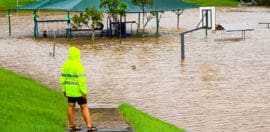Budget prioritises climate change protection and preparedness

25 October 2022 at 11:43 pm
The environment is a clear winner in the federal budget, with natural disaster, conservation and renewable energy initiatives getting slices of the funding pie.
Clean energy innovation, electric vehicle tax cuts and biodiversity protection are just a few of the climate-focused wins to come out of the Albanese government’s first federal budget.
According to The Conversation, climate change is mentioned across 16 pages of the main budget document, with “total climate-related spending [in] at $25 billion over 2022-23 to 2029-30”.
The federal budget has pointed towards ongoing support for communities affected by natural disasters, which treasurer Jim Chalmers said were occurring with “alarming regularity”.
In his parliamentary address, Chalmers acknowledged that “once again we are reminded of the solidarity that living on this harsh land demands of our people and our communities. It speaks to a unique Australian way of responding to adversity: looking out for each other and looking after each other – and lifting each other up.”
He said the effects of climate change “come with broader consequences – for the economy and for the budget”.
To better prepare for future disasters, up to $200 million will be invested per year in prevention and resilience initiatives through the Disaster Ready Fund, which will support projects such as flood levees, sea walls, cyclone shelters, evacuation centres and fire breaks.
$22.6 million over four years will also be awarded to help reduce the cost of insurance in disaster prone communities.
The funding comes as Australia’s south-east coast continues to battle major floods, which have devastated businesses, agriculture and homes – an experience echoing the NSW and QLD floods earlier this year, which claimed the lives of more than 20 people and left tens of thousands homeless.
To safeguard Australia’s future from the effects of climate change, the government has enshrined in law emissions reduction targets of 43 per cent by 2030 and net zero by 2050.
It has also invested $42.6 million to restore the Climate Change Authority to provide transparency on Australia’s progress, and $45.8 million towards clean energy trade partnerships and international climate engagement.
The government will also provide $105.2 million to support First Nations people to respond to climate change in their communities.
A strong statement of $1.8 billion will fund action to protect, restore and manage the natural environment, with an initial investment of $91.1 million over six years to clean up and restore urban waterways, protect local species and improve liveability for communities.
$1.2 billion will be allocated by 2030 to preserve and restore the Great Barrier Reef, while $224.5 million will go to threatened native species.
The Australian Conservation Foundation (ACF) said the “government has started to turn around a decade of savage cuts to the environment budget, but it has a long way to go before nature protection and restoration is adequately funded”.
“The federal government has set the right goal – zero new extinctions – now it needs to back it with policies, laws and funding,” said ACF chief executive Kelly O’Shanassy.
“The budget has increased funding for environmental protection and climate action, but has continued most of the Coalition’s support for fossil fuel industries, including the Fuel Tax Credits scheme, which subsidises the diesel use of multinational mining companies and will cost taxpayers $39.4 billion over the forward estimates.
“Public money for fossil fuel expansion, especially gas, continues to undermine good work on renewable energy and nature protection.”
When it comes to renewable energy, the federal government is committing to building 10,000 kilometres of new transmission lines, unlocking $55 billion of public and private investment, and enabling 82 per cent renewable-based grid by 2030, in its efforts to build a future with cleaner and cheaper energy.
To cut taxes on electric cars and encourage their uptake, the $345 million Electric Car Discount will exempt eligible electric cars from fringe benefits tax (FBT) and the 5 per cent import tariff.
Half a billion dollars has been allocated to reduce transport emissions, while the government has pledged over $300 million to support community batteries and solar banks. The New Energy Apprenticeships and New Energy Skills programs will also get a boost of over $100 million, addressing growing skills demands in the clean energy sector.
Earlier this week, a budget leak revealed that the Albanese government would provide an additional $588 million in 2022-23, to “help to support Services Australia in quickly responding to emergencies and natural disasters”.
Government services minister Bill Shorten said in a press release on Monday that the funding will help the country better prepare for “more climate-induced emergencies”.
“Some of these emergencies, floods and fires, have been back to back – with the previous government sitting on their hands and refusing to act.
“Bitter experience of the last three years of natural disasters shows it is smarter and more economical to pre-position a ready-to-go workforce ahead of disasters, rather than the more expensive ad hoc reaction of assembling a workforce from scratch after the disaster has occurred.”







